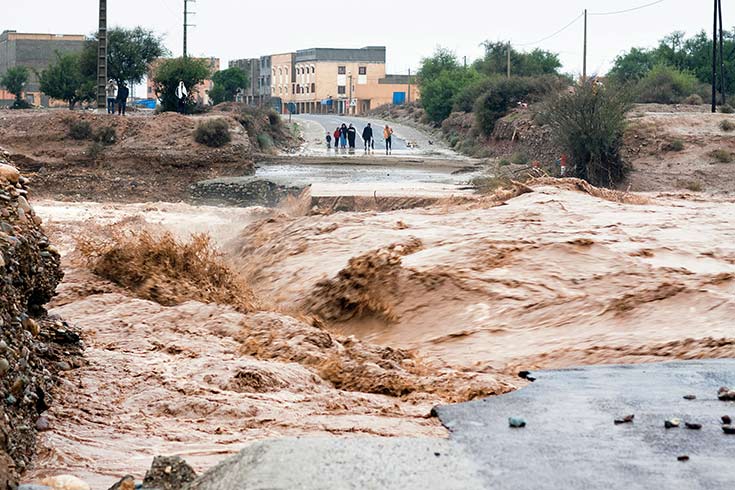World Risk Report 2016: Inadequate infrastructure pushes up the risk of disaster
Inadequate infrastructure and weak logistic chains substantially increase the risk that an extreme natural event will become a disaster. This is a core finding of the World Risk Report 2016, published by the United Nations University Institute for Environment and Human Security (UNU-EHS) and Bündnis Entwicklung Hilft – Gemeinsam für Menschen in Not eV, in co-operation with the University of Stuttgart.

Flooding in Souss Massa Draa, Morocco, 2014. A powerful stream of water destroyed a bridge in Sidi Ouaaziz. Assistance after extreme natural events is often hampered by damage to infrastructure (Mikhail Mandrygin / 123rf)
“When it comes to aid measures following extreme natural events, the challenges mostly lie in the ‘last mile’ of the logistics chain: organising transportation despite destroyed streets or bridges and ensuring fair distribution when there is a shortage of water, food, and shelter,” explained Peter Mucke, Project Director of the World Risk Report and Managing Director of Bündnis Entwicklung Hilft. “Crumbling transport routes, unreliable electricity grids, and dilapidated buildings not only hinder humanitarian aid from overseas, but also delay crucial aid for those affected in the event of a disaster.”
“The international community must invest more in development and maintenance of critical infrastructure even before disasters occur,” said Dr Matthias Garschagen, Scientific Director for the report and Lead Scientist at the UNU Institute for Environment and Human Security (UNU-EHS). “Sufficient, high-quality infrastructure, which is well-managed institutionally, can not only prevent the often catastrophic consequences of natural hazards, such as flooding or storms, but it can also play a crucial role in the distribution of humanitarian aid supplies in the event of a disaster. Critical infrastructure can thus reduce the risk of natural hazards for populations and it can mitigate economic losses.”

Building in Adis Ababa (Aleksandr Frolov / 123rf)
Dr Iris Menn, Programme Director at Bündnis member Christoffel-Blindenmission (CBM), emphasised the growing importance of locally organised humanitarian aid: “Actors on site, for instance civil-society and church organisations, are often fully familiar with the local, cultural situation and know the people who most urgently require assistance. They are the first ones who can take action in the event of a disaster and they are also there when the international aid organisations leave again.”
An important part of the report is the World Risk Index, which was calculated by the Institute of Spatial and Regional Planning at the University of Stuttgart (IREUS). The index assesses the risk of disaster in 171 countries through the combined analysis of natural hazards and societal vulnerabilities. The island state of Vanuatu once again displays the greatest risk in 2016 (see CRJ 12:4 for an article on mass evacuation preparations in Vanuatu).
“Societal factors, such as nutrition, medical services, and governance, decide to a large extent whether a natural hazard becomes a disaster,” said Dr Torsten Welle, Senior Scientist at IREUS. “But through targeted interventions, the impacts of disasters can be reduced and important lessons can be learned from recognised weaknesses.”
The report can be downloaded here.